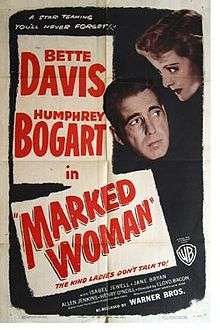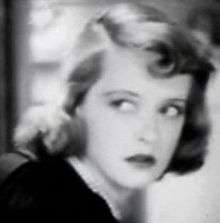Marked Woman
| Marked Woman | |
|---|---|
 theatrical poster | |
| Directed by |
Lloyd Bacon Michael Curtiz (uncredited) |
| Written by |
Robert Rossen Abem Finkel Seton I. Miller (uncredited) |
| Starring |
Bette Davis Humphrey Bogart |
| Music by |
Score: Bernhard Kaun Heinz Roemheld David Raksin (all uncredited) Songs: Harry Warren Al Dubin |
| Cinematography | George Barnes |
| Edited by | Jack Killifer |
Production company | |
| Distributed by | Warner Bros. |
Release dates |
|
Running time | 84 minutes |
| Country | United States |
| Language | English |
Marked Woman is a 1937 American dramatic crime film released by Warner Bros. It was directed by Lloyd Bacon, and stars Bette Davis and Humphrey Bogart, with featured performances by Lola Lane, Isabel Jewell, Rosalind Marquis, Mayo Methot, Jane Bryan, Eduardo Ciannelli, and Allen Jenkins. Set in the underworld of Manhattan, Marked Woman tells the story of a woman who dares to stand up to one of the city's most powerful gangsters.
The film was a major success for Warner Brothers, and was one of Davis' most important early pictures. Davis had recently filed a lawsuit against Warners, with part of her protest being the inferior quality of scripts she was expected to play. Although she lost the lawsuit, she garnered considerable press coverage, and Marked Woman was the first script she filmed upon returning to Hollywood. She was reported to be very pleased with the script and the dramatic possibilities it afforded her. Jack L. Warner was said to be equally pleased by the huge public reaction in favour of Davis, which he was said to have rightly predicted would increase the appeal and profitability of her films.
Co-stars Humphrey Bogart and Mayo Methot were reported to have met on the set of Marked Woman and were married in 1938.[1]
Background
Despite the disclaimer at the beginning of the film that asserts that the story is fictitious, Marked Woman is loosely based on the real-life crimefighting exploits of Thomas E. Dewey, a District Attorney for Manhattan who became a national celebrity in the 1930s, and two-time Republican Party presidential nominee in the 1940s, due to his fight against organized crime in New York City. Dewey indicted and convicted several prominent gangsters; his greatest achievement was the conviction of Lucky Luciano, the organized crime boss of the entire city. Dewey used the testimony of numerous call girls and madames to convict Luciano of being a pimp who ran one of the largest prostitution rings in American history. Dewey's dramatic achievements led Hollywood film studios to make several films about his exploits; Marked Woman was one of the most prominent. Humphrey Bogart's character, David Graham, is based on Dewey.
Warner Bros. purchased the rights from a Liberty series on Luciano, but was forced to make alterations in the story, such as changing the women's profession from prostitutes to "nightclub hostesses", because of censorship concerns.[1]
Plot
Mary Dwight Stauber (Bette Davis), a nightclub hostess who works for the notorious gangster Johnny Vanning (Eduardo Ciannelli) briefly meets and befriends a young man (Damian O'Flynn) who confides in her that he does not have the money to repay the gambling debt he has accrued during the night. He feels that it's a game, but Mary warns him that he is in real danger. She is shocked, but not surprised to learn soon after that he has been murdered, by Vanning's henchman Charlie Delaney (Ben Welden).
Questioned by prosecutor David Graham (Humphrey Bogart), Mary and the other women refuse to implicate Vanning. They fear his retribution, and while privately detesting him are powerless to free themselves from his influence. Mary's younger sister Betty (Jane Bryan) comes to visit, and unaware of the dangerous situation she has entered, behaves recklessly against the advice of her older sister. When she is killed, Mary agrees to testify against the gangster. Beaten by his thugs, scarred and disfigured, she becomes the "marked woman" of the film's title, but rather than silencing her, it strengthens her resolve to testify. Aware that they can only be free of the gangster if they find the strength to stand against him, the other women agree to testify also.
Cast

|
|
- Cast notes
- Eduardo Ciannelli bears a physical resemblance to Lucky Luciano.[2]
- Hymie Marks, who played the bit part of a gangster named "Joe" in the film, attracted the attention of executive producer Hal B. Wallis, who felt that he did not look menacing enough – this despite the fact that Marks was a former gangster and henchman of Lucky Luciano, who had been specifically cast by director Lloyd Bacon because of that connection.[3][3]
- Warners had originally cast Jane Wyman as "Florrie".[1]
Production
Marked Woman went into production on December 9, 1936[4] at the Warner Bros. studios in Burbank[5] under the working title "The Men Behind".[1] Director Michael Curtiz stood in for Lloyd Bacon while Bacon was on his honeymoon.[1]
When Davis was made-up for the scene in the hospital room, she was unhappy with the minimal bandaging that had been used, so on her lunch break she drove to her personal doctor, described the injuries that the script called her character to have, and had him bandage her accordingly. When she returned to the studio, a guard at the gate saw her bandages and called executive producer Hal B. Wallis to tell him that Davis had been in an accident.[3]
Warners re-released Marked Woman in 1947.[1]
Awards and honors
Bette Davis won the Venice Film Festival's Volpi Cup for Best Actress in 1937. Director Lloyd Bacon was nominated for the 1937 Mussolini Cup.[6]
Notes
External links
| Wikimedia Commons has media related to Marked Woman (film). |
- Marked Woman at the Internet Movie Database
- Marked Woman at the TCM Movie Database
- Marked Woman at AllMovie
- Marked Woman at Rotten Tomatoes
- LIFE 19 Apr 1937 - Movie of the Week 'Marked Woman'